The Perfect Family Vacation to India
ABOUT
At Our Whole Village, we plan meaningful vacations for families who want to create lifelong memories and show their kids the world in a more conscious and intentional manner.
WORK WITH US
We help families take meaningful vacations so that they can escape everyday life, show their kids the world and make lifelong memories - with care, confidence and peace of mind.
THE BEST FAMILY VACATIONS BY AGE
Your (free) guide to the top travel destinations for families with babies, teens and everyone in between.
DOWNLOAD NOW
ABOUT US
May 24, 2023
What’s one of the best places to visit on a family vacation to India? India’s Golden Triangle, which includes three icons in Northern India — New Delhi, Agra, and Jaipur — is the perfect starting point for first-time visitors.
Rajasthan offers a wide variety of experiences sure to keep your family entertained. Historical attractions include Jama Masjid, one of Asia’s largest mosques, the Sikh house of worship of Gurudwara Bangla Sahib.
In Jaipur, check out the City Palace Royal Museum compound before heading to Janta Mantar, the royal astronomical observatory. Besides touring historical sites and checking out the stars, you’ll enjoy chances to ride in a rickshaw, go on a tiger safari in Ranthambore National Park, and much more.
In Agra, you won’t want to miss out on Fatehpur Sikri, a Mughal-era fort and, of course, the region’s crowning glory, the Taj Mahal.
Keep reading to find out more about the perfect India family trip.
Explore New Delhi by Rickshaw
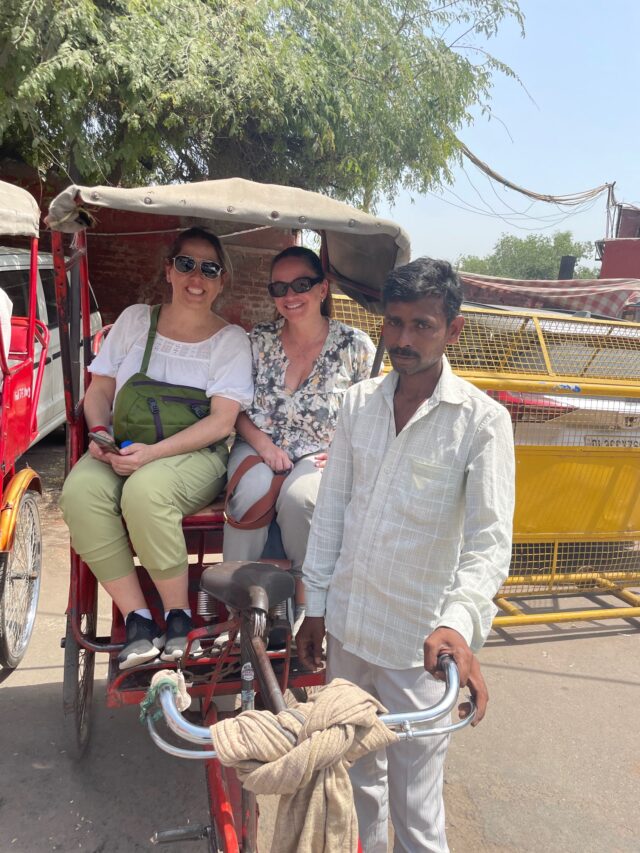
© Our Whole Village
Where to go in India? One of the best places to start is New Delhi. This bustling city can be divided into two sections, Old and New Delhi. Old Delhi lives up to its name, chock full of ancient and medieval monuments, archaeological sites, and remnants of the past. Construction began under the Mughal emperor Shah Jahan who envisioned a great walled city.
George V, Emperor of India, and Queen Mary spearheaded New Delhi starting on December 12, 1911, when they announced the relocation of the British Raj’s capital from Calcutta to Delhi. They brought in two of the 20th century’s leading British architects, Sir Edwin Lutyens and Sir Herbert Baker to realize their plans. Today, New Delhi continues to house many governmental buildings as well as the nation’s Parliament.
One of the most exciting ways to explore Old Delhi is by rickshaw. Not for the faint of heart, it allows you to navigate narrow lanes while taking in the iconic and dynamic experiences available in this historic district. They include seeing the Chandni Chowk (Silver Square), the Khari Baoli (a wholesale spice market), and the Kimari Bazaar where you’ll bone up on colorful sari material shopping.
Uncover Delhi’s Multilayered History
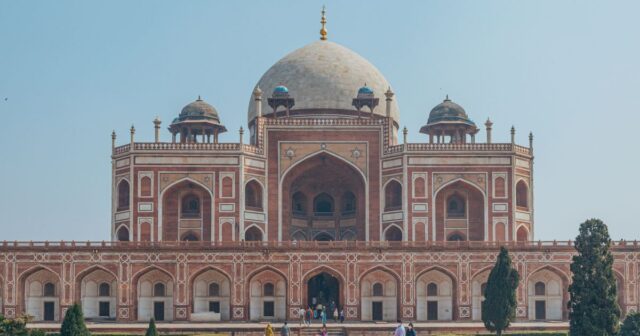
© Shantanu Goyal | Pexels via Canva
You’ll also enjoy opportunities to explore Humayun’s magnificent tomb, built in A.D. 1565 to house the corpse of Emperor Humayun. The site includes stunning gardens and the double-domed tomb.
At Gurudwara Bangla Sahib, tour a Sikh house of worship. The iconic location is instantly recognizable with its tall flagpole and golden dome and was originally a bungalow owned by Raja Jai Singh, a 17th-century ruler. Stepping back even further in time, explore the Agrasen Ki Baoli, a 14th-century archaeological site where you’ll learn more about Maharaja Agrasen.
New Delhi’s multi-layered past comes to life at the Gandhi Sanghralaya or National Gandhi Museum. This museum highlights the life of one of the world’s most influential thought leaders, Mahatma Gandhi. Among his greatest achievements was advocating for non-violence in his opposition of Colonial British rule. The museum includes a rich collection of 20th-century artifacts bearing witness to Gandhi’s life and vision.
Step Back in Time at the Agra Fort
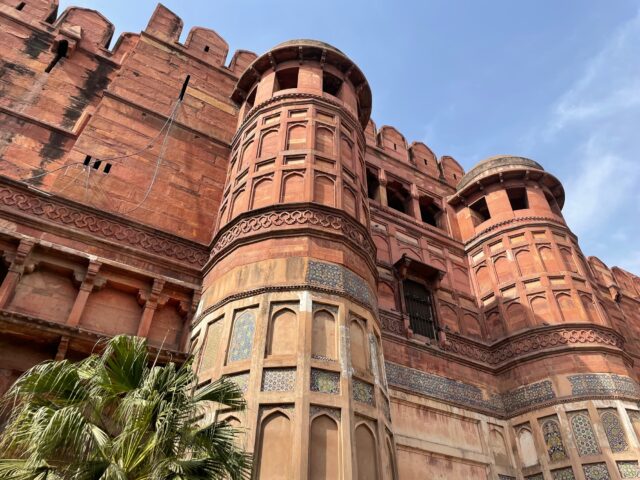
© Our Whole Village
The UNESCO World Heritage Site Agra Fort dates to the 11th century A.D. Initially constructed in red sandstone, this impressive site gained attention under the reign of Mughal Emperor Akbar Mughal beginning in 1558.
From the 16th through the 18th centuries, the Mughal Empire controlled vast swathes of the Indian subcontinent. Among the most famous emperors of the dynasty were Humayun, Akbar, and Akbar’s grandson Shah Jahan. All told, six rulers once reigned over India, known collectively as the Great Mughals, and ruling as Muslims over a large Hindu majority.
Historical changes are evident in Agra Fort’s impressive structural developments. They include significant renovations of the fort’s red sandstone by Akbar. Later, Shah Jahan spearheaded the addition of the white marble palace inside the fort. To learn more about this artisanal craft, head to a marble workshop where the art of inlaying precious gems in marble continues. Savor the chance to scope out the Taj Mahal at sunset with views afforded across the Yamuna River.
See Sunrise at the Taj Mahal
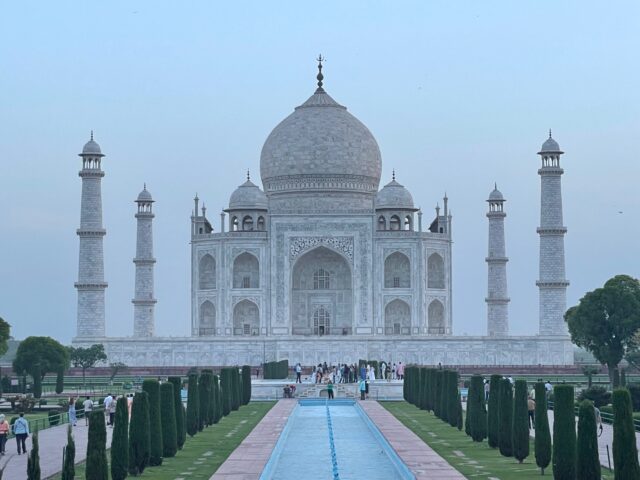
© Our Whole Village
Views of the Taj Mahal from Agra Fort prepare you for a monumental day of exploration at the Taj Mahal. This UNESCO World Heritage Site lives up to its reputation as Emperor Shah Jahan’s loving memorial to his wife Mumtaz Mahal after her death.
One of the most beautiful times of day to explore it is sunrise when light colors the pristine white façade in a stunning array of warm shades. The Taj Mahal took 22 years to build and has stood at the site since A.D. 1653. An estimated 20,000 workers labored to complete Shah Jahan’s vision of love and devotion.
After the emperor’s death in 1666, his remains were interred next to his beloved wife. Today, the symmetrical building remains one of the most recognizable images of India. You’ll also enjoy exploring its splendid gardens and expansive reflecting pool. So, leave ample time for loading up on selfies and family photos.
Visit Ancient Fatehpur Sikri
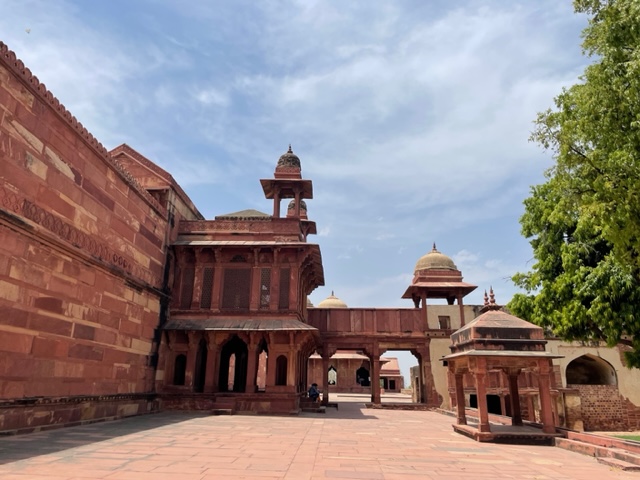
© Our Whole Village
Now that your family has become familiar with the history of the Mughal Empire, it’s time to head to Fatehpur Sikri, its former capital. Fatehpur Sikri only operated as the headquarters of the Mughals for 14 years, however. Why? Because of a lack of water coupled with social unrest in northwest India.
From Fatehpur Sikri, the Mughals relocated to Lahore. Nevertheless, they left behind an impressive complex of temples and monuments. These include Jama Masjid, one of the largest mosques in India.
You’ll also find the Buland Darwaza or “Door of Victory” constructed in 1575 by Emperor Akbar to celebrate his conquest of Gujarat. Another reminder of Akbar is the Panch Mahal or “Five-Level Palace,” which he commissioned near the Zenana Quarters (harem) as a retreat for relaxation and entertainment.
Last but not least, check out the Tomb of Salim Chishti. Built from 1580 to 1581, it’s considered one of the best examples of Mughal architecture in all of India. The tomb enshrined the Sufi saint, Salim Chishti, who lived in a cavern on the ridge of Sikri. Not only did the saint lead a notable life, but he foretold the birth of Akbar’s son, Prince Salim.
Go Wild on a Tiger Safari in Ranthambore National Park
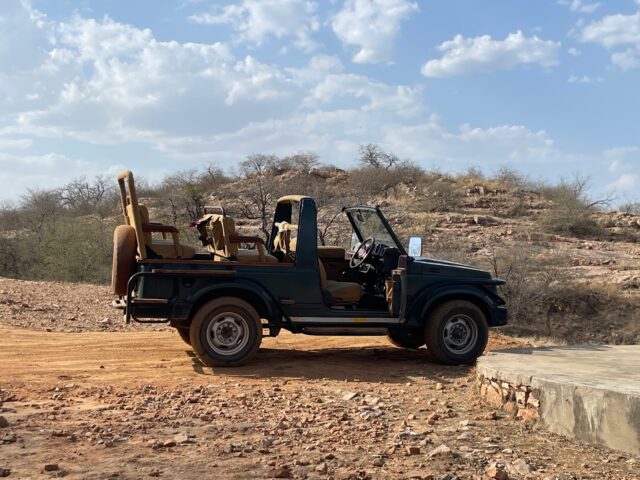
© Our Whole Village
When it comes to what to do in India, you’ve got abundant options. But one of our favorite experiences remains a visit to Ranthambore National Park. One of the most renowned national forest reserves in North India, it’s located in Sawai Madhopur district. Home to a diverse array of wildlife, get ready for adventurous wildlife viewing and photo snapping.

© Claire Hearn
What can you expect to see? Everything from peacocks to deer, monkeys to crocodiles, and just about every shape and size animal in between. But one of the park’s biggest treats is heading out on a Bengal tiger safari. The park includes ten zones where you stand an excellent chance of seeing the elusive orange-and-black-striped royalty of the jungle.
Of course, you’ll also want to keep your eyes peeled for some of the park’s other residents. They include a rich collection of birds, mammals, and reptiles. Because of the incredible variety of life, this park has become a hotspot for nature photographers over the years. So, come prepared to snap photos of the incredible cacophony of life in this lush setting.
Tour the “Pink City” of Jaipur
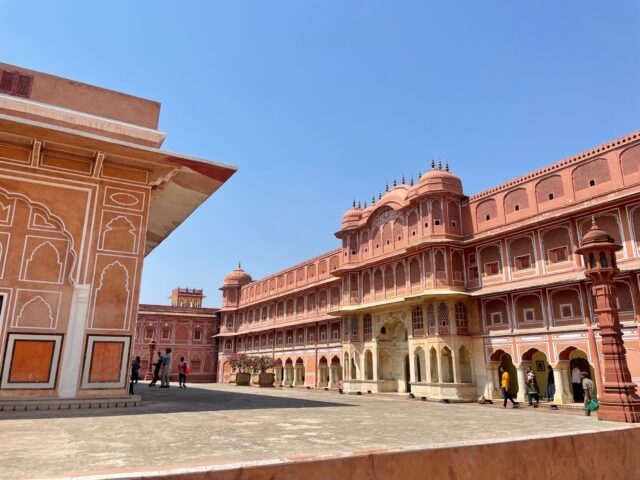
© Our Whole Village
Jaipur’s reputation as the “Pink City” can be attributed to its rose-colored architecture. This pastel-hued terracotta welcomed Prince Albert to the city in 1876. But the city boasts a much longer history.
Founded on November 18, 1727, by Maharaja Sawai Jai Singh II, the city enjoyed a historical role as the capital of Rajasthan As a result, you’ll find numerous ancient forts and opulent palaces in Jaipur. These include the City Palace, which became a museum in 1959, and features a spectacular combination of Mughal and Rajasthani architecture.
At the colorful Jantar Mantar, explore an astronomical observatory dating to the 18th century. Another intriguing location is the Palace of the Winds, constructed to allow the women of the royal household to observe the goings-on of city life without being seen by its residents.
Other highlights include a visit to a textile shop to learn about the art of hand block printing. And you won’t want to miss out on a tour of a local flower and vegetable market. More noteworthy landmarks include the Hawa Mahal, a five-story testament to Rajput architecture that overlooks a busy bazaar street, and Amer Fort with its red sandstone exterior and white inner palace overlooking Maota Lake.
Discover the Majesty of Udaipur
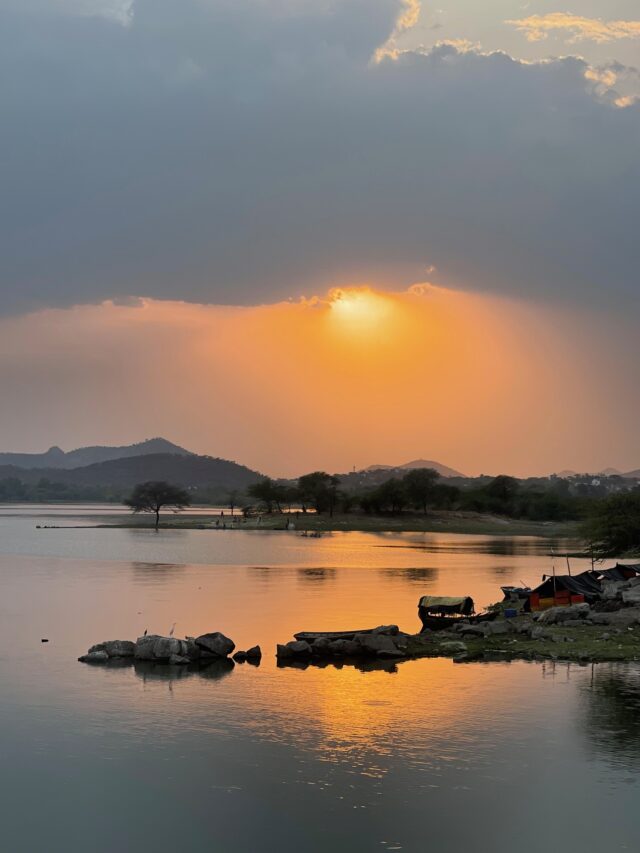
© Our Whole Village
Maharana Udai Singh founded Udaipur, the “City of Lakes,” in A.D. 1559. The capital of the former Mewar state, Udaipur is located on Lake Pichola’s eastern banks. Surrounded by the Aravalli Mountains, this bright city is an ideal family vacation spot because of the wealth of fun-filled activities it offers.
A must-visit location is the City Palace. The 400-year-old palace is one of the architectural wonders of Rajastan and is located along the picturesque banks of Lake Pichola. The birthplace of Maharana Pratap, it remains emblematic of Mewar pride. The majestic palace complex combines the best in Mughal and Rajasthani architectural styles. Despite being built over the course of generations, it demonstrates a remarkable continuity of style.
Jagdish Temple was constructed in A.D. 1651. It provides an excellent example of the Indo-Aryan style. Maharana Jagat Singh spearheaded its construction. Singh ruled over Udaipur from 1628 through 1653, and he dedicated the temple to Lord Vishnu. In the Hindu religious tradition, Lord Vishnu is considered the preserver of the Universe.
For families with a little extra time, head to Sahelion Ki Bari. Built by Maharana Sangram Singh in the mid-18th century, its “Garden of the Maids” is well worth the visit. It provides a wonderful glimpse into the inner lives of ladies of the court centuries ago. It includes four pools, abundant flowers, verdant lawns, and fountains protected by shaded trees and a series of walls.
Sightsee in Mumbai
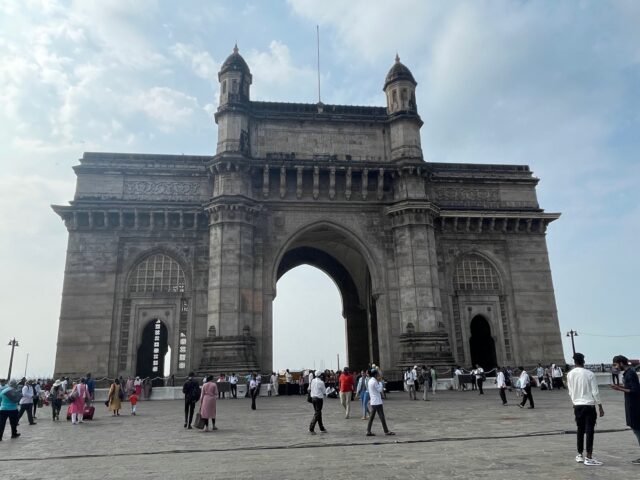
© Our Whole Village
Moving on to the city of Mumbai comes with many chances to explore India’s incredible heritage. At the Gateway of India, discover a monument commemorating the visit of George V and Queen Mary in December 1911. Built from concrete and yellow basalt, work began in 1915 and stretched through the landmark’s opening in December 1924.
Next, it’s on to Elephanta Caves, located on an island in the Sea of Oman near Bombay. The cave includes impressive carvings linked to the cult of Shiva. But it received its name in the 17th century from Portuguese explorers. These sailors found a large elephant sculpture near the cave system’s entrance, hence the title. Sadly, they attempted to remove the elephant sculpture only to have it fall into the depths of the ocean because their chains failed.
At the former Victoria Terminus (now the Chhatrapati Shivaji Terminus), explore British influences on Indian architecture. Constructed in 1887, the station bears markers of the High Victorian Gothic style of architecture coupled with influences from the Mughal and Hindu traditions.
And don’t forget about a visit to Dhobi Ghat, a famed open-air laundromat that’s more than 140 years old. Workers are known as Dhobis, and they busily wash the clothes from Mumbai’s hospitals and hotels in rows of open-air concrete wash pens. Each of these pens contains its own flogging stone.
Family Vacation to India
History and culture meet in India, creating an intoxicating union of exotic sights, sounds, flavors, and experiences. The nation has weathered several empires as attested in Mughal and British-influenced architecture. And you’ll never run out of fascinating sites to visit, from the iconic Taj Mahal to the Elephanta Caves, the Jantar Mantar to Dhobi Ghat.
Ready to start planning your family vacation to India? We’re here to help. We’ve got the local connections, inside knowledge, and family travel expertise to ensure you benefit from the best family vacation ideas for India.
Let’s chat!
OUR SERVICES
HOME
COPYRIGHT © OUR WHOLE VILLAGE 2021
DESIGN BY GIRLBOSS DESIGNER | CUSTOMIZED BY ALEX COLLIER DESIGN
about
TRAVEL SERVICES
DESTINATIONS
BLOG
PLAN A TRIP
FREE TRAVEL GUIDE
TERMS AND CONDITIONS
hello@ourwholevillage.com
+1 305 432 2612
